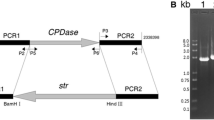Abstract
MutS1 is a key protein involved in mismatch repair system for ensuring fidelity of replication and recombination in Deinococcus radiodurans. The zwf gene encodes glucose-6-phosphate dehydrogenase (G6PD) in the pentose phosphate (PP) pathway, which provides adequate metabolites as precursors of DNA repair. In this study, mutS1 and zwf were disrupted by homologous recombination. The zwf mutant (Δzwf) and the zwf/mutS1 double mutant (Δzwf/mutS1) were sensitive to ultraviolet (UV) light, H2O2, and DNA cross-linking agent mitomycin C (MMC), whereas the mutS1 mutant (ΔmutS1) showed resistance to UV light, H2O2 and MMC as the wild-type strain. Inactivation of mutS1 resulted in a 3.3-fold increase in frequency of spontaneous rifampicin-resistant mutagenesis and a 4.9-fold increment in integration efficiency of a donor point–mutation marker during bacterial transformation. Although inactivation of zwf had no obvious effect compared with the wild-type strain, dual disruption of zwf and mutS1 resulted in a 4.7-fold increase in mutation frequency and a 7.4-fold increase in integration efficiency. These results suggest that inactivation of the PP pathway decreases the resistance of D. radiodurans cells to DNA damaging agents and increases mutation frequency and integration efficiency in the mutS1 mutant background.


Similar content being viewed by others
References
Bonacossa de Almeida C, Coste G, Sommer S et al (2002) Quantification of RecA protein in Deinococcus radiodurans reveals involvement of RecA, but not LexA, in its regulation. Mol Genet Genomics 268:28–41
Erneld D, Demain AL (1969) Glucose-6-phosphate dehydrogenase and its deficiency in mutants of Corynebacterium glutamicum. J Bacteriol 98:1151–1158
Garibyan L, Huang T, Kim M et al (2003) Use of the rpoB gene to determine the specificity of base substitution mutations on the Escherichia coli chromosome. DNA Repair 2:593–608
Kim M, Wolff E, Huang T et al (2004) Developing a genetic system in Deinococcus radiodurans for analyzing mutations. Genetics 166:661–668
Levin-Zaidman S, Englander J, Shimoni E et al (2003) Ringlike structure of the Deinococcus radiodurans genome: a key to radioresistance? Science 299:254–256
Lu AL, Li X, Gu Y et al (2001) Repair of oxidative DNA damage: Mechanisms and functions. Cell Biochem Biophys 35:141–147
Makarova KS, Aravind L, Wolf YI et al (2001) Genome of the extremely radiation-resistant bacterium Deinococcus radiodurans viewed from the perspective of comparative genomics. Microbiol Mol Biol Rev 65:44–79
Mellon I, Champe GN (1996) Products of DNA mismatch repair genes mutS and mutL are required for transcription-coupled nucleotide-excision repair of the lactose operon in Escherichia coli. Proc Natl Acad Sci U S A 93:1292–1297
Mennecier S, Coste G, Servant P et al (2004) Mismatch repair ensures fidelity of replication and recombination in the radioresistant organism Deinococcus radiodurans. Mol Gen Genomics 272:460–469
Minton KW (1994) DNA repair in the extremely radioresistant bacterium Deinococcus radiodurans. Mol Microbiol 13:9–15
Nishidal H, Narumi I (2002) Disruption analysis of DR1420 and/or DR1758 in the extremely radioresistant bacterium Deinococcus radiodurans. Microbiology 148:2911–2914
Pandolfi PP, Sonati F, Rivi R et al (1995) Targeted disruption of the housekeeping gene encoding glucose-6-phosphate dehydrogenase (G6PD): G6PD is dispensable for pentose synthesis but essential for defense against oxidative stress. EMBO J 14:5209–5215
Rayssiguier C, Thaler DS, Radman M (1989) The barrier to recombination between Escherichia coli and Salmonella typhimurium is disrupted in mismatch repair mutants. Nature 342:396–401
Satoh K, Narumi I, Kikuchi M et al (2002) Characterization of RecA424 and RecA670 proteins from Deinococcus radiodurans. J Biochem 131:121–129
Schofield M, Hsieh P (2003) DNA mismatch repair: Molecular mechanisms and biological function. Annu Rev Microbiol 57:579–608
Tanaka M, Narumi I, Funayama T et al (2005) Characterization of pathways dependent on the uvsE, uvrA1, or uvrA2 gene product for UV resistance in Deinococcus radiodurans. J Bacteriol 187:3693–3697
Tian WN, Braunstein LD, Pang J et al (1999) Importance of glucose- 6-phosphate dehydrogenase activity in cell death. Am J Physiol 276:1121–1131
Xu XH (1992) General microbiology. China Agriculture University, pp 131–132
Zhang YM, Liu JK, Wong TY (2003) The DNA excision repair system of the highly radioresistant bacterium Deinococcus radiodurans is facilitated by the pentose phosphate pathway. Mol Microbiol 48:1317–1323
Zhang YM, Wong TY, Chen LY et al (2000) Induction of a futile Embden-Meyerhof-Parnas Pathway in Deinococcus radiodurans by Mn: possible role of the pentose phosphate pathway in cell survival. Appl Environ Microbiol 66:105–112
Acknowledgments
The authors thank Yuejin Hua for reading the typescript. This work was supported by the Ministry of Science and Technology of China (National Basic Research Program Grant No. 2007CB707805 and National High-Tech Program Grant Nos. 2007AA021305 and 2006AA020101) and National Natural Science Foundation of China (Grant Nos. 30470047 and 30670050).
Author information
Authors and Affiliations
Corresponding author
Rights and permissions
About this article
Cite this article
Liu, X., Wu, J., Zhang, W. et al. Resistance of Deinococcus radiodurans to Mutagenesis Is Facilitated by Pentose Phosphate Pathway in the mutS1 Mutant Background. Curr Microbiol 57, 66–71 (2008). https://doi.org/10.1007/s00284-008-9154-4
Received:
Accepted:
Published:
Issue Date:
DOI: https://doi.org/10.1007/s00284-008-9154-4




